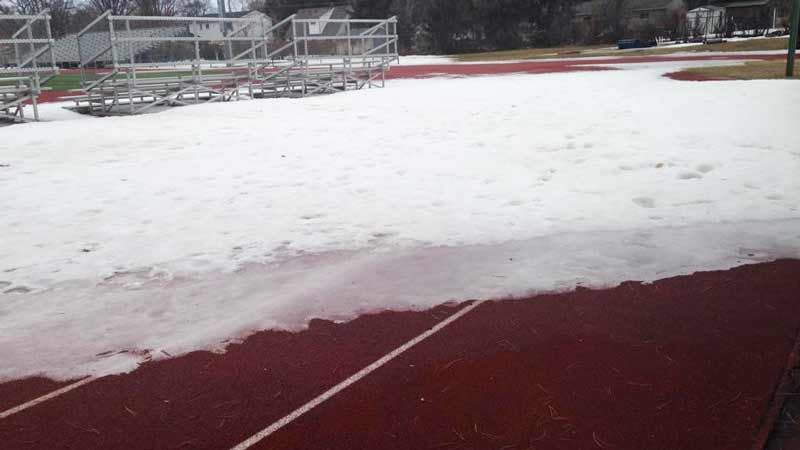
By Roger White
The Idea
At the Canadian Speed and Power Conference in November 2014, I listened attentively to Coach Dan Pfaff and absorbed every word he said. One of Dan’s many stories involved resilience and contingency planning. In simple terms, it involves making “what if this happens?” plans. As an example, Dan asked, “What happens in the pole vault if you start the competition with a tail wind and the sun is out? But then the wind turns, and it starts raining. What do you do?” In other words, how can you develop contingency plans?
Dan shared the story of long jumper Greg Rutherford at the London Olympics. Dan knew the jumps would go in a certain direction for TV purposes. He knew the wind direction that would likely occur when jumping in that direction. In the competition, Dan stated that the field averaged four fouls while Greg had zero. Dan said Greg was likely only the 4th best jumper in the field. But he was the best jumper that day, in large part due to resilience and contingency planning.
I’ve always left conferences with the mindset that I will take the information presented and apply it to my situation the best I can. So here’s how I utilized Dan’s contingency plan concept this past season with two athletes I coached at our high school state finals.
Challenges of High School Meets
Coach-athlete accessibility
I would guess that many, if not most, high school track teams have dual meets, tri-meets, and weekend invitational or relay-style meets. Coaches usually have access to the entire facility during these meets, even if announcements are made to “stay out of the infield.” As a result, coaches at these meets, especially distance coaches, hug the track yelling splits (I’m often warned for running back and forth from the finish line to the 200m mark to keep up with my runners.)
But at championship meets, security personnel at the track entrances only let athletes through. The trackhugging split yellers now have to go into the stands or creatively find the closest, least crowded area to do their race rituals. The accessibility of the coaches to their athletes has changed.
Racing tactics
My top athletes may go all season without being challenged much, and if they are, only by one or two others. Enter championship meets. Every athlete is essentially of similar ability (there are usually a few exceptions who stand out). How does this impact race tactics? If a distance runner is accustomed to sitting on the leader and outkicking them, will this work at state? How will sprinters who often do much better in their second race of the day run knowing that their first race is really their “final” in order to advance? What planning must the coach and athlete do to handle these situations?
Weather & extreme temperatures
Another issue I face in Michigan is our crazy spring weather. Typically my track is covered with 12 inches of snow and ice every March when the season starts. I’ve shoveled hundreds of meters of track and had the team walk around to pack it down to speed up the melting process (and yes that did work for us this year). We even tried using snow blowers but got into some trouble with the school. Then as April comes, the weather “warms” to maybe 50F. Those of you in warm states are probably laughing, but the reality is that at 50F, our kids have their shirts off and are ready to hit the beaches!

Figure 1: First day of practice. Track is covered with snow. Had to get out the shovels and brooms.
May brings frequent wet weather and increasingly warm temperatures leading to our end of May/early June state finals, often with 80F+ temps. Physiology tells us it takes a few weeks to acclimate to the heat, and every year I see kids underperform in the heat at this meet. How do the coach and athletes handle the environmental aspect of the meet?
How we developed and practiced contingency plans
Dealing with the weather
As this past season progressed, one of my girls looked to be a near-guarantee for state finals in the 1600 and/or the 800, and another one in the 100mH and 300mH. In early May, the weather began to warm, and Dan’s words “what if?” rang in my head. The previous season, my girls 4×400 team qualified for state finals (the last event, usually around 4 pm in the afternoon). The weather prediction was “hot,” but it had been cool all season. I had them wear sweatshirts during the week leading up to state. It wasn’t ideal, but better than nothing. Even if this tactic had no physiological benefit, there was perhaps a mental one. The girls had done “heat training” to prepare.
This year, I decided to get a jump on things. We started wearing these clothes four weeks out. Sure enough, 80-degree weather came in early May, and my distance runner was wearing sweats. (Without going into much detail, athletes who exercise in high temperatures have slight changes in their body cooling process often resulting in slower performances, particularly in the aerobic events.) Her first workout was ugly. Though she met the desired times, it took considerable effort and she pretty much collapsed afterward. I reminded her that she would be happy she did all this when she had to run in hot weather at state.
Eliminating my “track-hugger split-yeller” side
During the year, I video recorded as many races as I could, particularly the sprints, relays, and field events. The distance events would get split results following the race, so everyone left with “something.” Knowing the scenario we would have at state finals with limited access and overcrowded areas, I decided to video the distance events from the stands and see how my distance runner raced without my doing diagonal sprints across the field or yelling times she likely wasn’t going to hear anyway. We did this for a few meets and had some great race debriefing dialogs (another one of Coach Pfaff’s topics).
Pre-race planning meetings
She eventually qualified in the 1600 and 800, with the 1600 her better event. She was ranked in the middle of the field, and needed a huge race to be in medal contention. As it approached, we talked several times about what type of race it was going to be. I knew that at meets like this, kids take the first lap way too fast. I didn’t want to talk too much and create increased anxiety for her, but eventually we watched the 1600 from a previous meet. As history often shows, there will likely be a few front runners, and then everyone else. In the everyone-else pack, some will maintain form and some will fall apart at the end.
In our pre-race chat at the hotel the night before, we discussed positioning off the cut line, where I would be standing, and what I would be yelling to her, hoping she could hear me. We even planned out—and had practiced in previous meets—her recovery leading up to her 800 about 60 minutes after her 1600. We had gone over what would happen if she finished in medal position, or if she didn’t. The last thing I wanted was her wandering around the infield when we could be doing post-race recovery on a limited time schedule.
The pre-race chat with the hurdler was a bit different. In the 300 she was ranked towards the bottom. So not much pressure there, just run fast and have fun. In the 100, she was middle of the field and would need an incredible race to advance to the finals. All season, she was always faster on her second run, so I had to account for that. Also, I knew that warm-ups at the start line are always congested, with 40 or so athletes trying to do their drills, warmups, and starts. Many of them get frustrated as coaches and other athletes cut across the track and often collide with each other. To avoid this, we talked about moving down the track to the finish line area where she could do her warmup free from any congestion.
Both runners and I also discussed transportation to the meet. The hurdler ran early, and the distance runner much later. They would get separate rides and had different wake-up times as well. We discussed their breakfast needs. My advice is always, “eat what you have always eaten on our Saturday meet days.” The last thing I want is a kid to eat a “Grand Slam Breakfast” combo because we are staying at a hotel when all season they only ate bananas for breakfast.
The last thing we discussed—and it was a bit of a curveball— was the weather. The prediction called for thunderstorms and rain all day, with temps in the 60s. So the warm weather stuff was for naught but certainly wasn’t a bad thing. The “curveball” was the potential for weather-related delays. The girls had never been in a meet when this happened. Many athletes and coaches try to time warmups based on race start times. A weather delay would throw a wrench into those plans.
I used to be one of those coaches. I tried to have athletes time their warmups, so their last fast run was “X” amount of time before their race, and so on. It rarely worked. Starters’ guns wouldn’t work (add another 5 minutes). Clerking issues would arise (add another few minutes). Sometimes, even the finish line timing system wouldn’t work (still another few minutes), and out goes my high-powered “potentiation warmup” plan.
My athletes’ warmups now are simple, require no timing, and in the odd case of delays, don’t mess them up physically or mentally. So I talked to the girls about how to mentally handle delays if they happened and told them to enjoy watching how others freak out at the thought of having to warm up again!
How things played out
As forecast, the weather that day was 60-degree temperatures and rain, a light drizzle increasing to a near downpour for segments and then drizzling again. There were no thunderstorms or delays.
The hurdler warmed up according to our plans, with no hitches. I extended her warmup time and intensity to have a “race #1” effect so her actual race would be like her second. We did have to head to the start line area to do block starts. And yes, four girls shared one lane and at my suggestion, rotated two starting blocks to speed things up, while the 100m runners did starts between lanes of hurdles with the 110mH guys zipping through as well. We did our starts, and she just chilled until her race was called, just like she usually did.
She ended up running a 0.3 second PR and finishing 10th, just missing the top-8 mark by 0.06 seconds. For her, contingency planning worked well, even though she came up a bit short of qualifying.
As the 1600 approached, my other runner went through her usual warmup, pre-race stretch out, and strides and then checked in. I was in the top corner of turn one where it wasn’t too crowded.

Figure 2: My position at the race looking up at the stands and all the umbrellas in the rain.
The gun went off. She ran her target time for the first lap and was right with the pack. Of course, a group of about 12 girls (all with 1600 times above 5:00) ran sub-70. I yelled her place. Lap two and she hit target pace again. I yelled her place once more and told her to chase a color jersey: “Go for Green!” Lap three and I did the same. She was gaining on girls and passed a few. Eighth was a possibility, but the gap was too large coming off the final turn. She finished 11th, with a 5-second PR. Though her place wasn’t as high as we had hoped, she did run incredibly well.
We had a post-race chat in the pouring rain on the way to our team tent. She said she could hear me on the first lap, and “kind of” on the second, but nothing afterward. When I said I was yelling for her to chase colors, she responded, “That would have been a great idea, but you kinda forgot to tell me you were going to say that. I had no idea what you meant.” I had made up some plans as we went along, but she had no idea what I was saying. Lesson learned.
Debrief
Although these stories pertain specifically to me, I am sure they resonate with coaches everywhere. We all have unique situations. As coaches, we want our athletes to perform well when it counts most. Have we done our job to prepare them for what they will face?
Please share this article so others may benefit.
[mashshare]


Great article! Can you explain how you “simplified” the warmup process to minimize issues arising from unforeseen delays?
Hi! Thanks for the question. The answer could another article in itself, but I’ll try my best to keep it short. First, in my master’s degree studies, I researched warm-up as part of my thesis. So I’m aware of what the literature has shown. Last year I had to give out an index card with our entire warm-up progression on it, and found it hard to do in meets. I’ve always wanted whatever we do it in practice to be replicated fairly easily in meets as well, so this year I changed a few things. We start with a serious of basic movements to get the body moving, things such as low amplitude skips, lateral shuffles, cariocas etc. We incorporate easy movements to check how the body is feeling, such as hip circles and hurdle trail leg motions. We do light static stretching to loosen up areas that are usually tight and do simple hurdle mobility step overs. They do a few basic sprint drills (all events) and a few strides/accelerations. At this point hurdlers would start their specific drills finishing with a few block starts to 2-3 hurdles when possible, usually never 1 hurdle. Most of this could be done in place as well. I’ve been at meets where clerks had kids in lines 20 minutes (mostly the case at indoor meets where space is limited). Hope this helps bring some clarity to your question!
Roger… As the father of Aimee who was a terrific athlete… I coached her undefeated softball season…But you have upped the anty by a mile with Meredith…. You are the personification of what a coach is….MEANING….you bring out the very best in your athletes, without hurting them (mentally or physically)…. I raced formula ford open wheel race cars for eight years, so I clearly understand the mental discipline that it take to compete at any level…..reading this blog of yours , it is obvious that you understand this and have passed it on to your athletes.. Meredith is one of the very fortunate runners that have had a coach like your that absolutely knows what it takes to move on to the next level…. And thanks to you she has moved on to the University of Huston….I only ask that you please keep an eye on her, lest she become contaminated….\